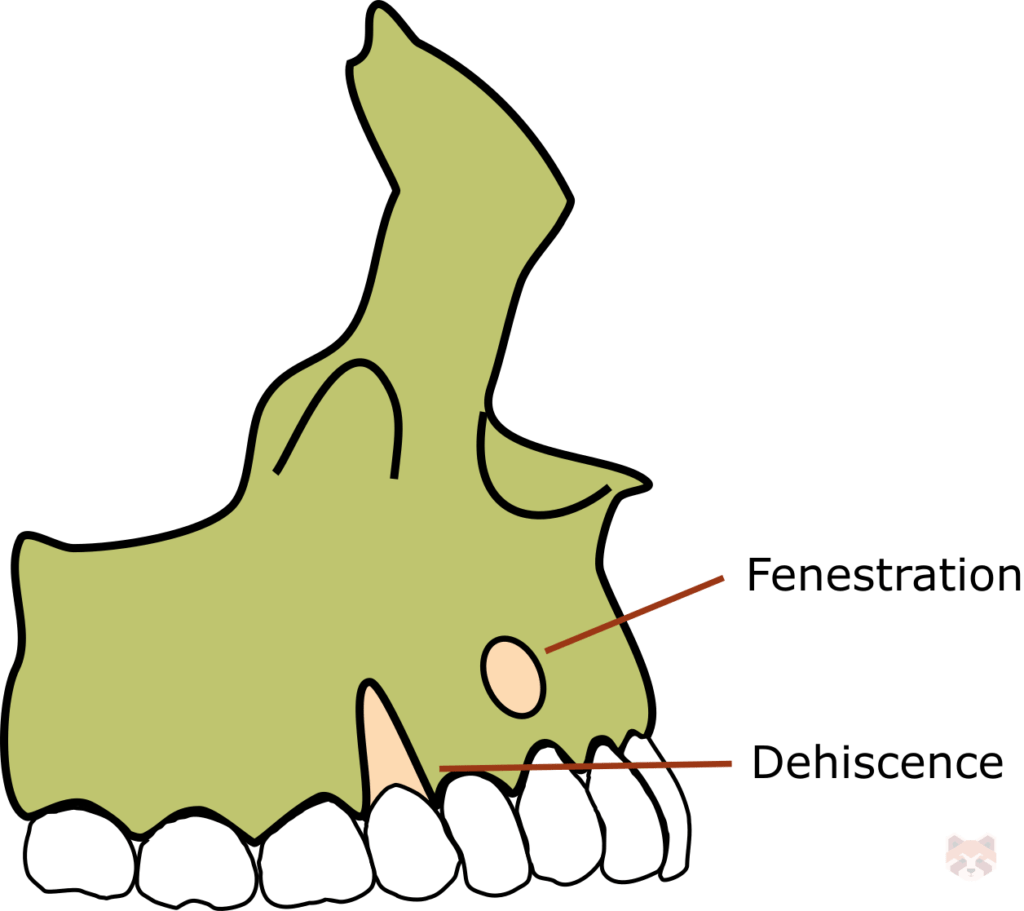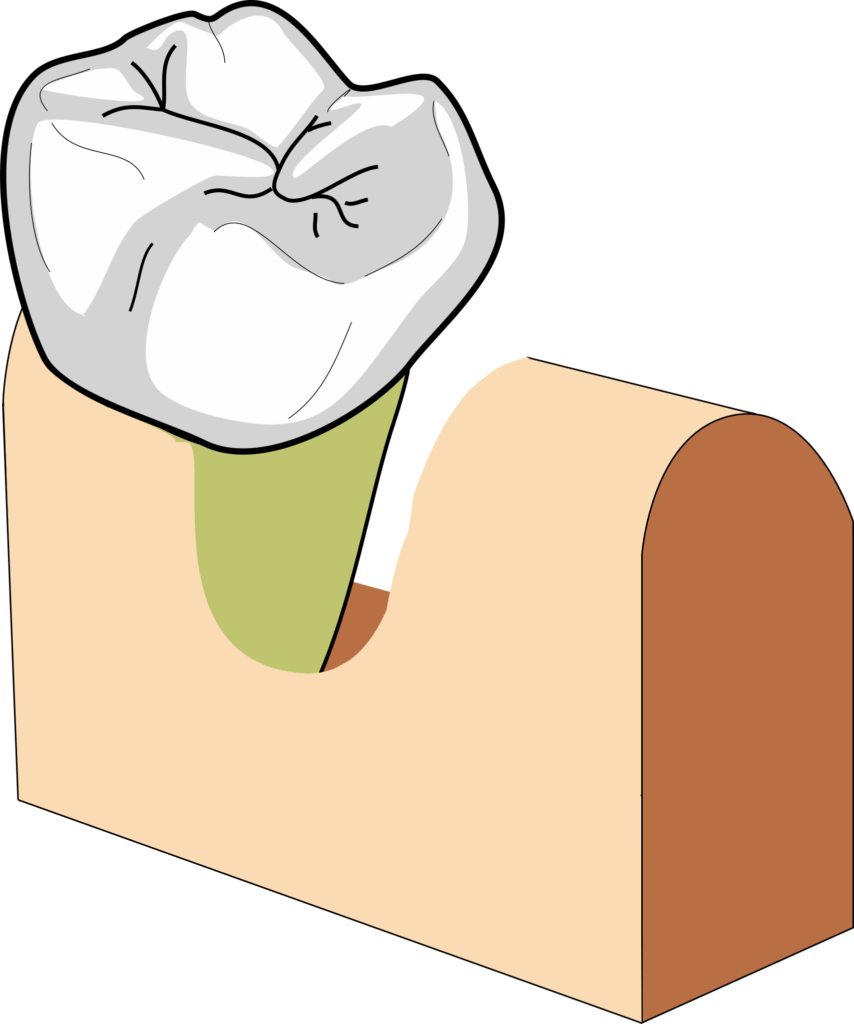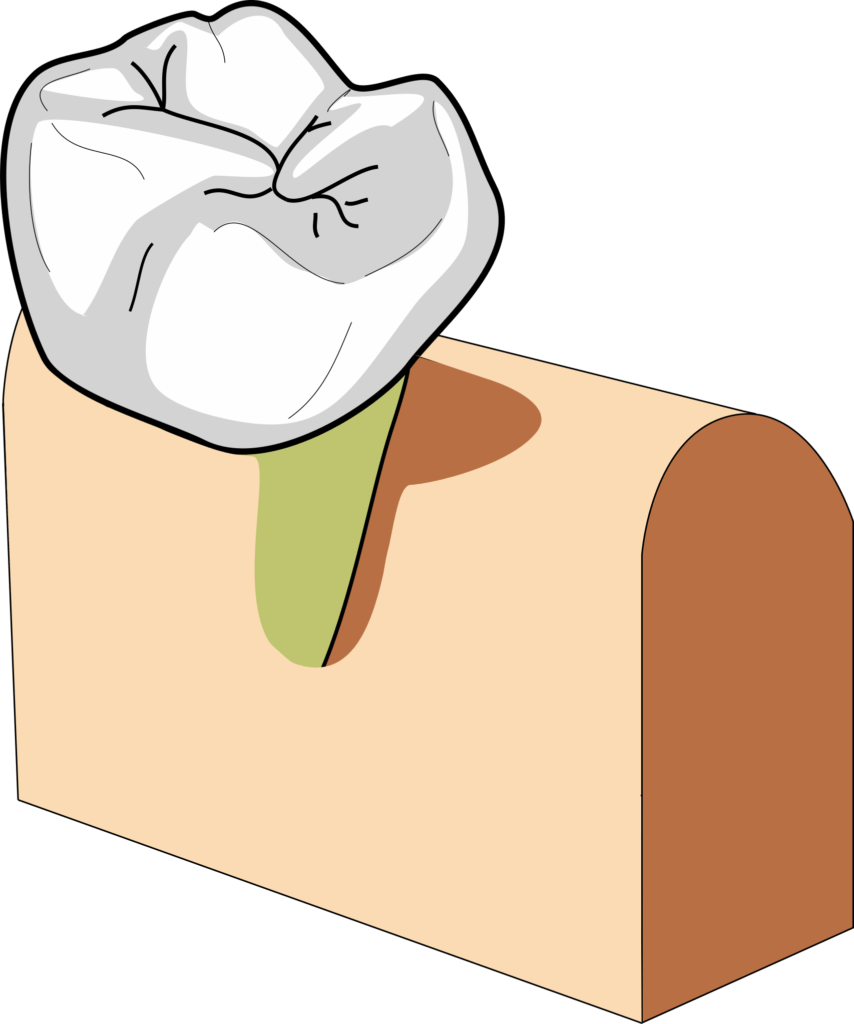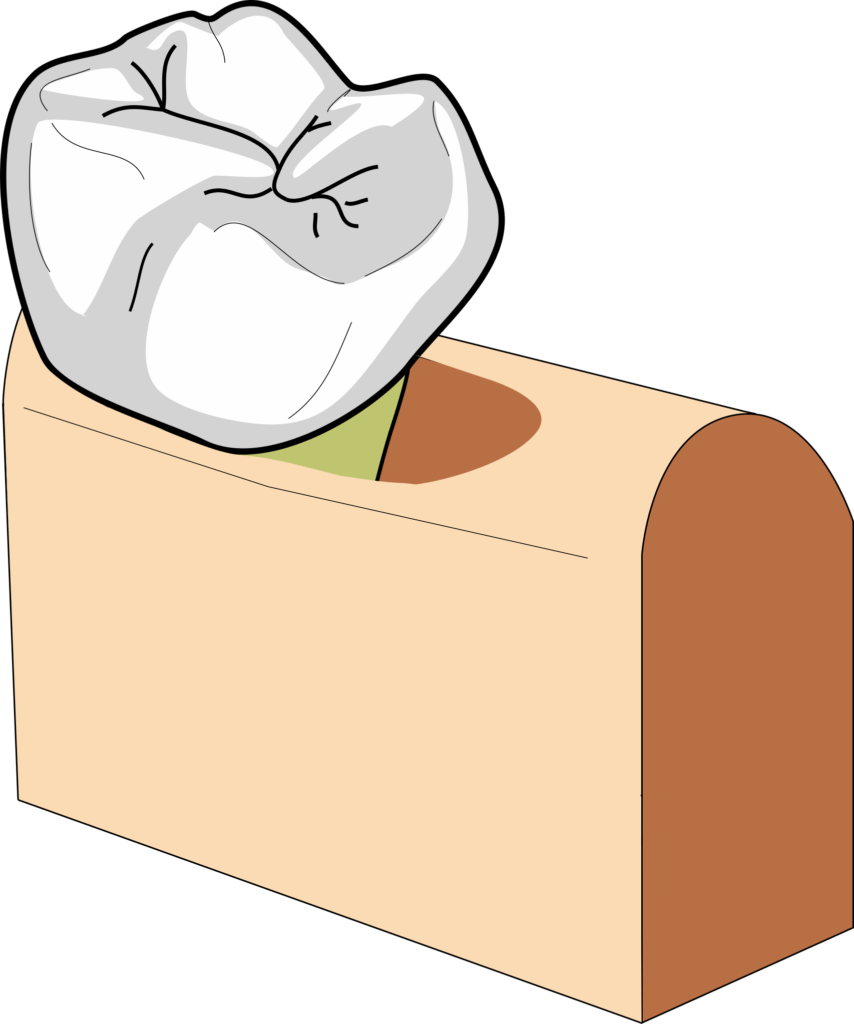Clinical Assessment
Master the INBDE with Dental Panda: Your go-to resource for expert practice exams and tailored study resources!
Probing pocket depth is the measurable distance from the gingival margin to the base of the gingival pocket, usually recorded in millimeters. A light probing force of about 25g is applied to a periodontal probe. Periodontal screening often includes 6 measurements, 3 on the buccal side and 3 on the lingual. Probing depths can be altered by the degree of gingival inflammation, the position and angulation of the probe, the presence of calculus, or interference from abnormal root morphology. The probe tip will be stopped by the junctional epithelium in a healthy pocket. The destruction of periodontal tissues in cases of periodontitis may mean the probe tip penetrates the supracrestal connective tissues.
Pseudo-pocketing (aka gingival, false or relative pockets) refers to the presence of gingival pockets without attachment loss, caused by the expanding of marginal tissue beyond their normal physiological level (e.g. gingival hyperplasia associated with Dilantin). All pseudo-pockets are suprabony, where the base of the pocket is positioned coronal to the crest of the alveolar bone. The degree of gingival enlargement can be categorized as follows:
- Grade 0 – no evidence of gingival enlargement.
- Grade I – enlargement only involving the interdental papillae.
- Grade II – enlargement that involves the interdental papillae and marginal gingiva.
- Grade III – enlargement that involves ≥3/4 of the crown.
Clinical attachment loss (CAL) describes an apical shift of the level of epithelial attachment. It is the most significant factor in regard to the prognosis of a periodontally involved tooth, more important than pocket depth. Clinical attachment loss is measured from the cementoenamel junction (CEJ) of the crown to the base of the pocket (epithelial attachment). In practice, measurement of the CAL can be challenging if the CEJ sits inferior to the gingival margin (not visible) and is not readily evident via tactile sensation. As periodontal disease progresses, the apical migration of the junctional epithelium can be measured with a periodontal probe. Periodontal disease can be classified according to the amount of clinical attachment loss (CAL):
- Slight – 1-2mm (would now be reclassified as Stage I).
- Moderate – 3-4mm (would now be reclassified as Stage II).
- Severe – more than 5mm (would now be reclassified as Stage III-IV).
Gingival recession refers to an apical shift of the free gingival margin. Recession is measured from the cementoenamel junction (CEJ) of the crown to the crest of the marginal gingiva. Gingival recession is associated with attachment loss, but the two are not synonymous. Gingival recession can be caused by a wide range of circumstances, including:
- Periodontal disease.
- Toothbrush or floss abrasion.
- High frenal attachments.
- Bony dehiscence.
- Parafunctional habits (e.g. gingivitis artefacta).
- Aging.
- Following periodontal treatment.
Bleeding on probing (BOP) is usually only seen in cases of disease and indicates active inflammatory periodontal disease. Healthy tissues should not present with bleeding after careful probing.
Periodontal Screening and Recording (PSR) uses a special PSR (WHO) probe with a small 0.5mm ball end. A single (highest) score for each sextant is all that is commonly recorded.
- Code 0 – Colored area remains entirely visible, no calculus, no bleeding.
- Code 1 – Colored area remains entirely visible, no calculus, bleeding on probing.
- Code 2 – Colored area remains entirely visible, calculus present, defective restorative margins.
- Code 3 – Colored area partially visible.
- Code 4 – Colored area submerged (pocket depth exceeds 5.5mm).

A periodontal abscess is a localized accumulation of pus within the gingival wall of a periodontal pocket. Periodontal abscesses are a common dental emergency and patients can present with acute swelling, increased tooth mobility, and pain. Though often an exacerbation of untreated periodontal disease, abscesses of non-periodontitis-related origin can develop following foreign object impaction (e.g popcorn). Treatment may include gingival sulcus curettage, mechanical debridement, and surgical drainage. In some cases antibiotic therapy may be appropriate. A tooth associated with multiple periodontal abscesses may have a hopeless prognosis, requiring removal.
When a dental abscess is located, the cause of the infection can be determined through a thorough medical and dental history, clinical examination and radiography. A combined endodontic-periodontic lesion occurs when an endodontic lesion extends into the periodontal lesion (pocket). When treating a combined lesion it is often recommended to start with the endodontic component, which may lead to complete resolution.
Suppuration (pus) refers to a purulent exudate that can be expressed from the inflamed periodontium through a fistula or from the gingival pocket. It is composed primarily of necrotic tissue, bacteria, and dead leukocytes. This discharge can be spontaneous or provoked by probing or pocket wall palpation. Suppuration may be more common in patients with severe periodontal disease, or in patients who have a poorly controlled systemic condition (e.g. diabetes, leukemia).
Fenestration describes an area where the bony coverage of the root surface is lost, leaving the root surface covered only by the periosteum and gingiva. The marginal bone remains intact. When this bone defect spreads to include the marginal bone it is called dehiscence. The area is now covered by tissue only. Gingivitis artefacta is a type of self-inflicted periodontal injury most commonly due to ”picking” or scratching of the gingiva with fingernails (or any foreign object).

Pathological mobility sees increased tooth movement due to connective tissue attachment loss. Mobility itself is not always a sign of irreversible pathology and in some cases may be transient. Examples include mobility seen during pregnancy, localized pathology (cysts, tumors), systemic diseases (e.g. osteoporosis), trauma, hypofunction and hyperfunction (e.g. bruxism). The Miller’s classification for tooth mobility:
- Class I – horizontal mobility less than 1mm.
- Class II – horizontal mobility in excess of 1mm.
- Class III – horizontal mobility in excess of 2mm and/or vertical mobility.
Significant attachment loss can lead to furcation involvement. The extent of furcation involvement can be assessed using the Glickman Furcation Classification:
- Grade I – early furcation involvement, where the clinician can feel the depression of the furcation opening with the probe. There is minimal bone loss around the furcation.
- Grade II – probe tip enters under the roof of the furcation but does not pass through underneath the tooth.
- Grade III – the buccal and lingual pockets are connected through the furcation but the furcation is not visible clinically due to gingival coverage.
- Grade IV – through-and-through opening that is visible clinically.

Of the proposed classifications, Miller’s classification of gingival recession is most widely used. The difficulty in identifying the mucogingival junction (MGJ) can create difficulties in the classification between Class I and II.
- Class I – Marginal tissue recession not extending to the MGJ. No loss of interdental bone or soft-tissue. The prognosis for root coverage is good to excellent.
- Class II – Marginal recession extending to or beyond the MGJ. No loss of interdental bone or soft-tissue. The prognosis for root coverage is good to excellent.
- Class III – Marginal tissue recession extends to or beyond the MGJ. Loss of interdental bone or soft-tissue is apical to the CEJ, but coronal to the apical extent of the marginal tissue recession. The prognosis for root coverage is less desirable, only partial coverage can be expected.
- Class IV – Marginal tissue recession extends to or beyond the MGJ. Loss of interdental bone extends to a level apical to the extent of the marginal tissue recession. The prognosis for root coverage is very poor.
Alveolar bone loss can be determined by examining the patient’s radiographs. In isolation this is not the most reliable measure of periodontal disease because of normal clinical variation. In health, the average distance from the CEJ to the crest of the alveolar bone is ~2 mm. Alveolar bone loss can be combined with probing measurements to provide a better picture of the patient’s periodontal health. Radiographic changes evident in patients with periodontitis:
- Early periodontitis – characterized by localized areas of erosion of the alveolar crest bone, often seen radiographically (on posterior bitewings) as blunting of the alveolar crest. Attachment loss of 1-2mm.
- Moderate periodontitis – continuation of bony destruction that may include the buccal and lingual plates. Radiographs may show evidence of generalized horizontal erosions or vertical defects. Attachment loss of 3-4mm.
- Advanced periodontitis – bone loss extensive enough to cause mobility, drifting and possibly leading to the loss of teeth. There is usually extensive horizontal bone loss and marked bony defects. Attachment loss of ≥5mm.
Horizontal bone loss is the most common pattern of bone loss that affects the interdental, facial and lingual bony plates. In relation to the teeth the height of the bone has been more or less uniformly decreased, though not to the exact same degree.
Vertical (angular) bone loss occurs in an oblique direction and leaves a hollowed out “trough” in the bone adjacent to the root. The base of the defect sits apical to the surrounding bone. Angular defects can be classified according to the number of osseous walls affected. The more bony walls present the greater the projected success rate of regenerative periodontal procedures. Narrow three walled bony defects stand a much better chance of favorable outcome compared to two walled defects. One-walled defects have the poorest prognosis.



A one-walled intrabony vertical defect can also be called a hemiseptum. The number of walls in the apical portion of the periodontal defect may be greater than the coronal portion, in which case it can be termed a combined osseous defect. The true nature of a periodontal defect is not observable externally (clinically) or on a 2 dimensional radiograph, but can be visualized with three dimensional radiography or after surgical exposure. ≥30% of bone decalcification needs to occur before defects are visible on radiographs.
A crater is a saucer shaped defect of soft tissue or bone. Gingival craters are corrected through gingivoplasty. Osseous craters are usually corrected by osseous recontouring.
SYSTEMIC DISEASE
There are a large number of systemic diseases and genetic disorders that could manifest with periodontal signs and symptoms, including:
- Ingestion of heavy metals (bismuth, lead, mercury).
- Hematologic anomalies/blood dyscrasias.
- Neutropenia (acquired, familial and cyclic).
- Leukemias or leukocyte adhesion deficiency syndromes.
- Down syndrome.
- Papillon-Lefèvre syndrome – multiple functional neutrophil defects.
- Chédiak-Higashi syndrome – decreased neutrophil chemotaxis and secretion.
- Infantile genetic agranulocytosis.
- Cohen syndrome.
- Hypophosphatasia.
- Ehlers-Danlos syndrome.
Periodontal infections may be linked to certain diseases or affect the regular progression of systemic conditions. Examples include:
- Cardiovascular & cerebrovascular conditions.
- Atherosclerosis.
- Coronary heart disease.
- Myocardial infarction.
- Angina.
- Cerebrovascular accident (stroke).
- Endocrine conditions.
- Diabetes.
- Reproductive conditions.
- Preterm low birth weight infants (LBW).
- Respiratory conditions.
- Chronic obstructive pulmonary disease (COPD).
- Pneumonia.
- Autoimmune conditions.
- Crohn’s disease.
- Rheumatoid arthritis.
- Lupus.
- CREST syndrome.
Diabetes is a known risk factor for periodontal disease and tooth loss. There is very little periodontal impact in a patient with well managed diabetes. Diabetic patients with poor diabetic control generally present with increased attachment loss, bone degradation, pocket depths, and increased susceptibility to periodontal infections. Diabetes does not directly cause periodontal disease but alters the host response by impairing polymorphonuclear leukocytes. Chronic hyperglycemia negatively affects the synthesis, maturation and maintenance of collagen and extracellular matrix (ECM).
Cigarette smoking is a known risk factor for periodontal disease and tooth loss. Smokers generally present with increased attachment loss, bone degradation, pocket depths, and increased susceptibility to periodontal infections. Smoking negatively impacts a patient’s immune system, hindering the patient’s cellular response (e.g. neutrophil inhibition) while causing increased expression of tissue-destructive enzymes. Orange and red microbial complexes are elevated in patients who are current smokers.
BRUXISM
Occlusion has very little significance related to periodontal disease, but occlusal trauma may act as a contributing factor. There is lack of evidence implicating occlusal trauma in the progression of attachment loss in periodontitis. Primary occlusal trauma refers to excessive force applied to a tooth or teeth with normal supporting structures. Secondary occlusal trauma occurs when normal occlusal forces become excessive because of compromised periodontal support. Periodontal pockets are not a result of occlusal trauma, but occlusal trauma may exacerbate periodontal problems. Occlusal trauma may be detected radiographically by:
- Widening of periodontal ligament space.
- Thickening of lamina dura.
- Angular bone loss.
- Root resorption.
- Hypercementosis.
Bruxism refers to repetitive or continuous grinding or clenching of the teeth that is not related to normal functional activities such as mastication, and can occur during wakefulness (diurnal bruxism) or when sleeping (nocturnal bruxism). Bruxism is seen in about 10-20% of adults, with diurnal bruxism more commonly seen in female patients. Bruxism may worsen damage to the teeth/restorations, exacerbate mobility, and cause muscle and joint pain. Bruxism does not directly cause periodontal pocket formation. Bruxism is thought to have a multifactorial etiology and can be caused by:
- Psychosocial factors.
- Peripheral factors.
- Pathophysiological factors (arousal response).
Treatment modalities involve occlusal correction, behavioral changes and pharmacological approach.
Selective grinding may be used to achieve a more favorable distribution of forces to minimize occlusal trauma. A clinician may start by removing premature contacts in centric relation, followed by protrusive interferences, followed by interferences during lateral excursive movements. Optimally the clinicians aims to:
- Direct forces along the long axis of the tooth.
- Coincide maximum intercuspation with centric relation.
- Eliminate interferences.
- Establish canine guidance or group function.
- Maintain occlusal vertical dimension and freeway space.
Selective grinding is contraindicated in the following:
- Enlarged pulp chamber.
- Dentine hypersensitivity.
- When there are major occlusal discrepancies that require orthodontic intervention.
- Cases where periodontal inflammation has not been stabilized.
